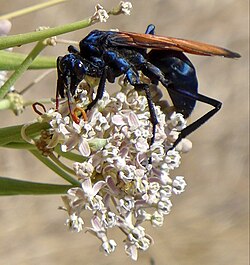Biology:Pepsis mildei
| Pepsis mildei | |
|---|---|

| |
| San Benito County, California, nectaring on milkweed | |
| Scientific classification | |
| Domain: | Eukaryota |
| Kingdom: | Animalia |
| Phylum: | Arthropoda |
| Class: | Insecta |
| Order: | Hymenoptera |
| Family: | Pompilidae |
| Subfamily: | Pepsinae |
| Genus: | Pepsis |
| Species: | P. mildei
|
| Binomial name | |
| Pepsis mildei (Stål, 1857)
| |
| Synonyms | |
|
Pepsis hesperiæ | |
Pepsis mildei, also known as Milde's tarantula-hawk wasp, is a species of predatory spider wasp native to the Western Hemisphere. These wasps capture live tarantulas to feed to their larva; the adults graze on flowers.[1] Tarantula hawks generally have no meaningful predators.[2] The wing color is black and/or orange, with rare leucistic wing coloration known in males.[3][4] The wings of P. mildei are duller overall than those of Pepsis grossa or Pepsis cinnabarina.[5] Per Edward Essig, Milde's tarantula-hawk wasp usually measures 20–30 millimeters in length and is a metallic blue-black overall, with "the antennæ reddish, dusky at extreme base in the male and the basal third dusky in the female; the wings fiery red with the bases and apices dusky".[5]
Pepsis mildei's range appears to be North America and Central America.[6] In the U.S. this wasp is relatively common and widely distributed; it has been documented in California, Nevada, Arizona, New Mexico, Utah, Colorado, Texas, Oklahoma, Kansas, and Arkansas.[4]
This species was synonymized with a species called Pepsis hesperiæ that was described by William Hampton Patton.[7] According to Paul David Hurd Jr. the Pepsis species angustimarginata and mildei "bear such a close morphological relationship that one is led to believe they arose from the identical ancestral stock."[4]
P. mildei is one of four tarantula hawk species known to frequent Quitobaquito Springs at Organ Pipe Cactus National Monument in Arizona, near the U.S.–Mexico border, along with Pepsis mexicana, Pepsis chrysothemis, and Pepsis pallidolimbata.[8]
The lifespan of males is one to two months, while female Milde's tarantula-hawk wasps live for a longer span of time.[1]
References
- ↑ 1.0 1.1 "Pepsis Wasp Fact Sheet". https://www.desertmuseum.org/kids/oz/long-fact-sheets/Pepsis%20Wasp.php.
- ↑ Schmidt, Justin O. (2004). "Venom and the Good Life in Tarantula Hawks (Hymenoptera: Pompilidae): How to Eat, Not Be Eaten, and Live Long". Journal of the Kansas Entomological Society 77 (4): 402–413. doi:10.2317/E-39.1. ISSN 0022-8567. https://www.jstor.org/stable/25086231.
- ↑ "Species Pepsis mildei - Milde's Tarantula-hawk Wasp". https://bugguide.net/node/view/40719.
- ↑ 4.0 4.1 4.2 "Revision of the Nearctic species of the pompilid genus Pepsis (Hymenoptera, Pompilidae)" (in en). pp. 274, 288–291. https://hdl.handle.net/2027/umn.31951000458598o?urlappend=%3Bseq=40.
- ↑ 5.0 5.1 "Insects of western North America : a manual and textbook for students in colleges and universities and a handbook for county, state and federal entomologists ..." (in en). pp. 883–884. https://hdl.handle.net/2027/iau.31858046836296?urlappend=%3Bseq=901.
- ↑ "Milde's Tarantula-hawk Wasp (Pepsis mildei)" (in en-US). https://www.inaturalist.org/taxa/54031-Pepsis-mildei.
- ↑ Washington, Entomological Society of (1896) (in en). Proceedings of the Entomological Society of Washington. Entomological Society of Washington. https://books.google.com/books?id=XQPyAAAAMAAJ&dq=Pepsis+mildei&pg=RA1-PA145.
- ↑ "A preliminary investigation of the arthropod fauna of Quitobaquito Springs Area, Organ Pipe Cactus National Monument, Arizona / Kenneth J. Kingsaley, ..." (in en). https://hdl.handle.net/2027/mdp.39015033341242?urlappend=%3Bseq=29.
Further reading
- Punzo, Fred (October 2005). "EXPERIENCE AFFECTS HUNTING BEHAVIOR OF THE WASP, PEPSIS MILDEI STÅL (HYMENOPTERA: POMPILIDAE)" (in en). Journal of the New York Entomological Society 113 (3 & 4): 222–229. doi:10.1664/0028-7199(2005)113[0222:EAHBOT2.0.CO;2]. ISSN 0028-7199. http://www.bioone.org/doi/abs/10.1664/0028-7199%282005%29113%5B0222%3AEAHBOT%5D2.0.CO%3B2.
External links
Wikidata ☰ Q49594306 entry
 |

